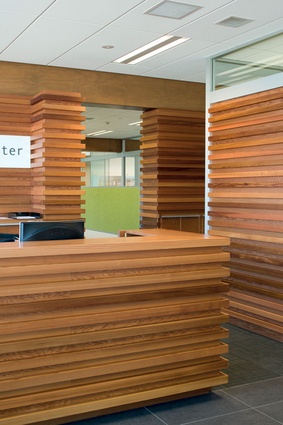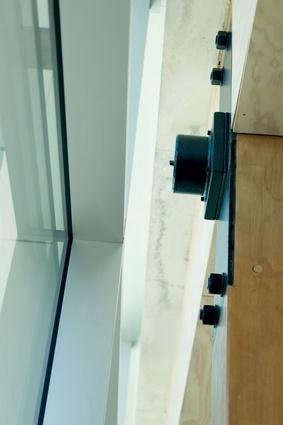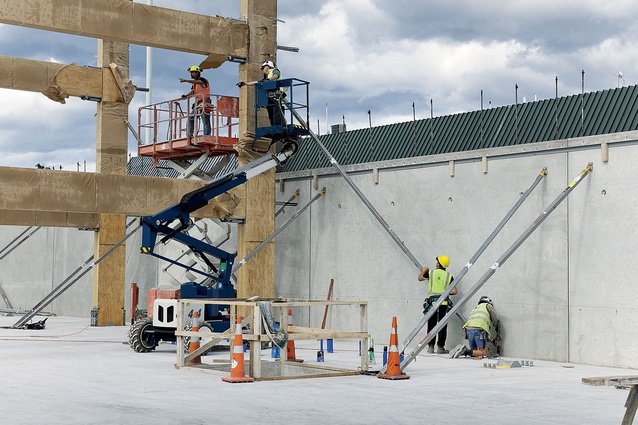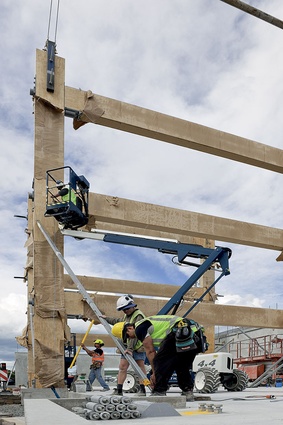Shock proof
‘World famous in New Zealand’ is a phrase we Kiwis use to describe something or someone that has attained such a level of recognition that it would, in any other setting, guarantee global adoration. When it comes to Young Hunter House in Christchurch, however, it’s safe to say that it’s world famous in, well, the world.
Designed by Sheppard & Rout Architects, there’s no denying that the building cuts a dashing figure, but good looks are not the reason for this building’s growing fan base.
“As a practice, we had been very keen to do a timber building, particularly within the context of the Christchurch rebuild,” says architect Jasper van der Lingen. “We were joined in this by Kirk Roberts and were aware that the University of Canterbury was conducting research into Precast Seismic Structural Systems (PRESSS) technology utilising post-tensioned timber.
“When [property owner] Tony Merritt approached us with the goal to building a multistorey timber office building, we saw an opportunity to bring all the pieces together.”
Sheppard & Rout, Kirk Roberts and a team from the University of Canterbury then set about the difficult task of turning theory into reality.
“The most complex issue in regards to PRESSS technology in timber is the stiffness to strength incompatibility compared to a material such as steel or concrete,” says structural engineer Jade Kirk.

“LVL-fabricated timber has relatively high compression strength but a very low modulus of elasticity, or stiffness, in comparison to concrete. Obviously, getting around this required some complex design and performance modelling of the moment resisting frames (MRF) joints, as we needed to ensure the beam-column joints would be stiff enough that during a seismic event joint opening occurs. This is to ensure that the correct amount of energy dissipation occurs in the yielding dissipaters versus the self-restoring compression force from the post tensioned tendon, which is forcing the frames back into equilibrium.”
Kirk and the university team knew the solution lay within the joint mechanism that would connect the columns to the beams.
“The major issue was being able to control the compression loads at the joint perpendicular to the timber grain, which can cause compression deformations to occur.
“Also, because timber is flexible, the beams can deform more in the elastic range than concrete, meaning that larger drifts and a larger elastic rotation can occur in the beam ends. This stops the gap opening mechanism from occurring at the column face, if not considered correctly.”
Another consideration adding to the complexity of the design was the owner’s desire for a cost-effective and visually reassuring building.
“Tony was on board right from the start in terms of using timber, however, he wanted cost guarantees that the solution offered would be comparable to steel or concrete,” says van der Lingen. “Also, in the time immediately following the earthquake the general public was, understandably, pretty nervous about safety, so Tony wanted a building that immediately imparted a sense of strength and security.”
“As a property developer, my main focus is on reducing maintenance issues so that my tenants can be assured of trouble free tenancies,” says Merritt.
“What we were hoping to achieve with this building was such new territory that the calculations, testing and performance reviews took place before the guidelines for the new technology had even been completed by the University of Canterbury.”
A fact not lost on the team from Contract Construction, headed by commercial and residential construction manager John Timlin.
“You can, theoretically, build anything on a piece of paper, getting it to work practically on the other hand is another matter entirely. Which was where we found ourselves with this project.
“We had the theory from the university and Kirk Roberts trying to make it work from a technological point of view – practicalities we work with every day but with this job it was the level of the unknown that made it difficult.”
One of the issues facing the construction team was the onsite assembly and erection of the LVL frames, which were delivered as separate elements.
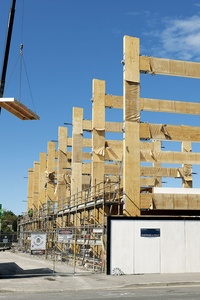
“Each frame comprises five individual pieces, all of which were dropped off in a finished state. Not only did we have to assemble them, we then had to lift them into place with no idea of whether or not the very process would damage them in some way. We ended up having to manufacture a shoe for the top of the frame when lifting,” says Timlin.
That wasn’t the only challenge the team faced with this build, zero tolerances even at the set out stage set the tone for the project, says site foreman Ian Hughson.
“This really was a challenging job. The level of accuracy was second-to-none, yet you also had to allow for movement at the same time. Then there was the interface between the timber structure and the concrete curtain wall, all of these intricacies that added further dimensions to the build.
“That said though, we couldn’t keep anyone from the job, everyone recognised that what was being achieved here was groundbreaking stuff and wanted to be a part of the process.”
That also extended to the public, engineers and industry professionals, both local and international.
“The project was generating such a buzz around it that it became almost impossible to keep people away – at one point a busload of Chinese engineers from a conference turned up. We had to have organised tours in the end as the only means of restoring some order to the system,” says Hughson.
For the building’s owner, its success lies in what the building offers the people of Christchurch.
“After the earthquakes, the biggest challenge was to rebuild in a way that would minimise damage and disruption while maximising safety. I truly believe with this building that we’ve hit on the solution. The final result is not only a structurally robust and safe building but, just as importantly, the exposed LVL system provides a natural, warm and reassuring element for those who use it.”


